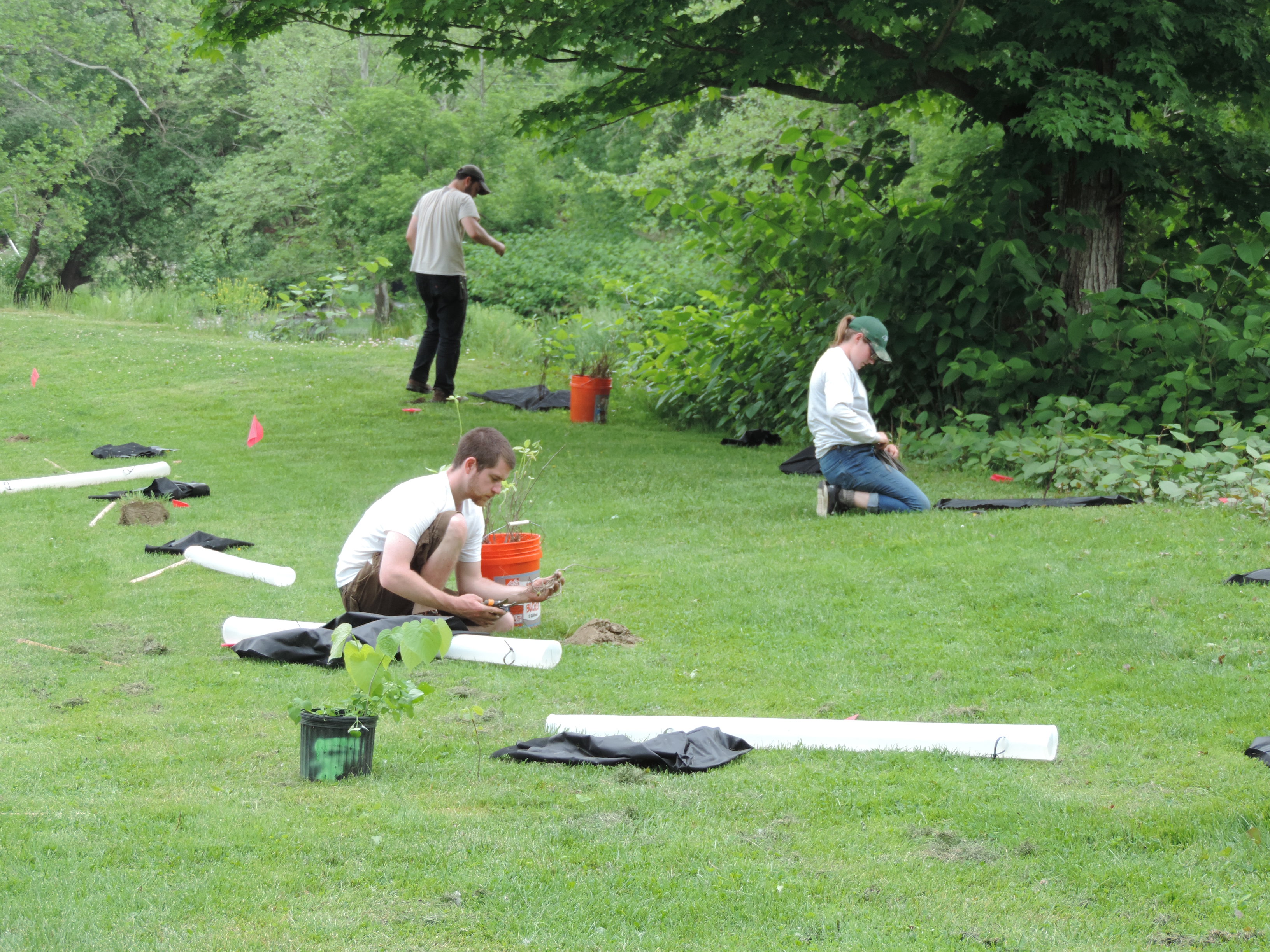
From left, Drew Grandmont, Jordan Bodway, Stephanie Reisenberg, Katelinn Carrier, Jim Molloy and Allie Holmes, all Trees for Tribs crew members, planted 100 trees and 100 shrubs on June 2 and 3 at Trout Ponds Park in Newark Valley, N.Y. (Photos by JoAnn R. Walter)

Pictured is Trout Ponds Park, located off of Spring Street in Newark Valley, N.Y. The park dates back to 1869 and is used today for community events along with pavilion rentals, and provides use of a playground, basketball court and baseball field.

Pictured are Trees for Tribs crew members planting trees and shrubs near the creek at Trout Ponds Park in Newark Valley, N.Y. The project creates a buffer, which in turn will reduce stream bank erosion, improve wildlife and habitat, increase floodwater retention and protect water quality.

The 2011 flood caused the creek bank to lose a number of trees and brush at Trout Ponds Park in Newark Valley, N.Y. Erosion resulted in the loss of at least seven to ten feet of the bank at different sections within the park. FEMA money replaced a large section of the bank, which included adding medium-sized rip-rap rock, as seen here.
Exciting work has been done at Trout Ponds Park, located off of Spring Street in Newark Valley, N.Y. As you enter the park, look along the creek side and take notice of several vertical white tubes and seedlings covered with mesh mats, spaced at specific intervals. About 100 trees and 100 shrubs were planted on June 2 and 3 by a crew from the New York State Department of Environmental Conservation’s (NYS-DEC) program, “Trees for Tribs,” most of them students from The State University of New York College of Environmental Science and Forestry (SUNY-ESF).
An initiative since 2007, the focus of Trees for Tribs is to reforest New York State tributaries such as small creeks and streams, which flow into larger rivers and lakes. By growing young trees and shrubs along riparian areas, or the area immediately next to a stream or river, a buffer is created, which in turn will reduce stream bank erosion, improve wildlife and habitat, increase flood water retention and protect water quality.
Overall, the stream will be healthier, and it also benefits the ecosystem and multiple other attributes downstream. It’s a win-win for the creek, wildlife and beauty at Trout Ponds Park and ultimately benefits the Susquehanna River and the Chesapeake Bay.
According to the NYS-DEC Watershed Implementation Plan, an ambitious goal of implementing over 10,000 acres of riparian forest buffers by the year 2025 was set, to help restore issues in the Chesapeake Bay.
For the Trout Ponds Park project, coordinated through the Tioga County Planning office and the Upper Susquehanna Coalition (USC), the NYS-DEC provided the plants and materials. The USC is a network of sixteen New York soil and water conservation districts and three Pennsylvania districts that work to protect and improve water quality and natural resources in the Upper Susquehanna River Basin.
Trees and shrubs from the State Tree Nursery were planted by the Trees for Tribs crew and included a combination of sycamore, basswood, red maple, silky dogwood, red oak, and pussy willow, among others. It will take time for the trees and shrubs to mature, and a small percentage may not survive, however the overall success rate will still yield positive results.
“The benefits for habitats will be seen really soon, and gradually over time other benefits will occur,” explained Lydia Brinkley, USC Buffer Coordinator, and added, “In about five years the trees will provide needed shade and more nutrients to the stream.”
Prior to the plantings, the Newark Valley Public Works Department cleared branches and took care of routine winter damage at Trout Ponds Park. Brinkley also explained that less mowing and maintenance previously done right up to the creek bank will actually be better for the creek.
Looking back five years ago, Newark Valley Public Works supervisor, Bill Foster explained that the 2011 flood caused the creek bank to lose a number of trees and brush, and erosion resulted in the loss of at least seven to ten feet of the bank at different sections within the park. With FEMA money, medium-sized rip-rap rock was added and tons of gravel and rocks were removed out of the main part of the creek to open up flow.
Foster shared, “Now the East Branch of Owego Creek by Trout Ponds Park has good fishing,” and he added, “In the near future many flowering trees and bushes will provide berries for animals and also add plenty of shade for the public to enjoy.”
Mayor Jim Tornatore commented, “We are also sharing our story to help raise awareness of what the USC can do to help municipalities and others.”
Trout Ponds Park dates back to 1869. Today, the park is a site for community events including summer musical entertainment, and along with pavilion rentals, provides use of a playground, basketball court and baseball field. Now when the public visits Trout Ponds Park, two signs explaining the Trees for Tribs project will be highly visible for visitors to view.
Another project by the USC is in process at Owego’s Hickories Park. Brinkley explained that a project which began in late May is still ongoing, which includes planting several hundred trees and shrubs.
For more information about the Upper Susquehanna Coalition, visit their website at www.u-s-c.org/ or find them on Facebook.


